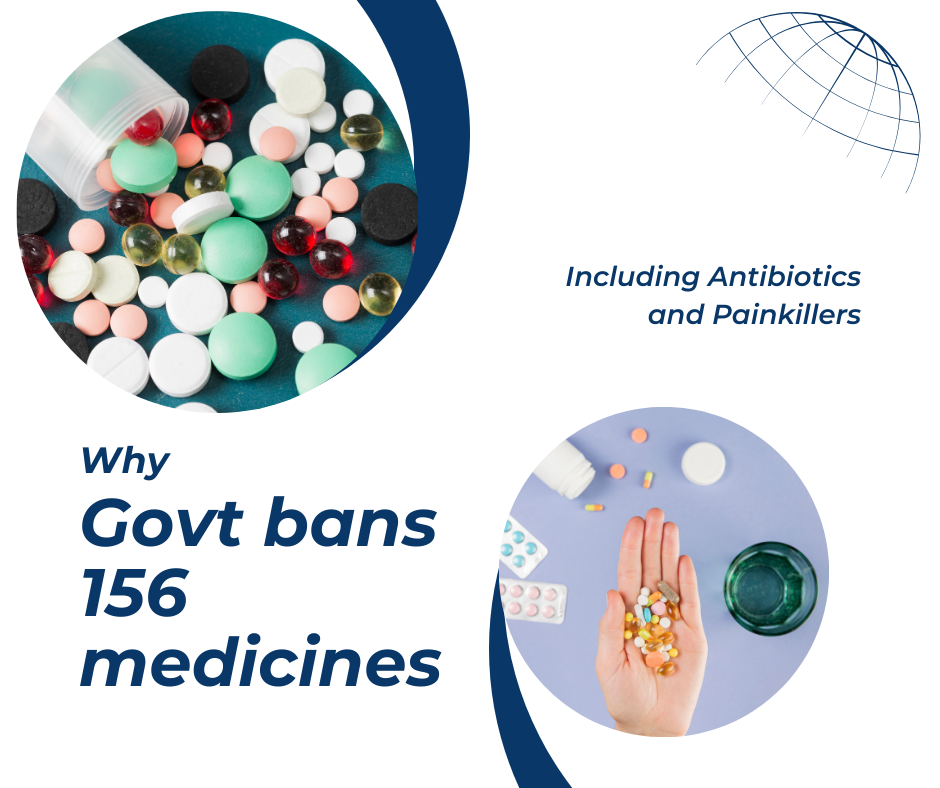
In a significant move aimed at safeguarding public health, the government has recently announced a ban on 156 medicines, including commonly used antibiotics, painkillers, and multivitamins. This decision has raised concerns among healthcare professionals, patients, and pharmaceutical companies alike. In this article, we will explore the reasons behind the ban, its implications, and the full list of affected medications.
The Reason behind the Ban
The Indian government recently banned 156 fixed-dose combination (FDC) drugs due to health concerns. An expert committee determined that these combinations lacked therapeutic justification. Additional FDCs are currently under review and may also face bans as part of ongoing efforts to ensure public safety.
The primary rationale for the government’s decision stems from safety concerns and the need to regulate the pharmaceutical market effectively. Authorities have identified that some of these medications pose potential risks to patients, either due to harmful side effects, ineffective formulations, or issues related to manufacturing quality.

Key Concerns:
- Quality Control: Many of the banned medications were found to violate standards set by health authorities, which could lead to compromised efficacy and safety.
- Public Health Risks: The misuse and over-prescription of certain antibiotics and painkillers have led to growing concerns about antibiotic resistance and dependency issues.
- Consumer Protection: The ban aims to protect consumers from substandard products that could endanger their health.
Implications of the Ban
The ban on these medications will have several implications for different stakeholders:
For Patients:
- Access to Medications: Patients may find it challenging to access alternative treatments, especially if they relied heavily on the banned medications.
- Awareness: There is a need for increased awareness regarding the potential risks associated with the use of these medicines, leading to better-informed decisions about health.
For Healthcare Providers:
- Adjustment of Prescriptions: Doctors will need to adapt their prescribing practices and may have to find alternative medications for their patients.
- Increased Monitoring: Healthcare providers may need to monitor patients more closely, especially those who were on long-term treatments with the banned drugs.
For Pharmaceutical Companies:
- Market Impact: Companies producing these medications may experience significant financial repercussions due to the loss of market share.
- Regulatory Scrutiny: The ban could lead to increased scrutiny on manufacturing practices, pushing companies to ensure compliance with safety standards.
Telegram CEO Pavel Durov Arrested: Implications of a Major Criminal Investigation
The Full List of Banned Medications
While the government has not released an exhaustive list of all 156 medications, some of the notable categories and examples include:
Antibiotics
- Amoxicillin: Commonly prescribed for bacterial infections.
- Ciprofloxacin: Used to treat a range of infections, including respiratory and urinary tract infections.
Painkillers
- Diclofenac: A widely used non-steroidal anti-inflammatory drug (NSAID).
- Tramadol: An opioid pain medication that has seen increasing misuse.
Multivitamins and Supplements
- Certain formulations containing high doses of specific vitamins: These have been flagged for potential toxicity and lack of proven efficacy.
Other Categories
- Cold and Flu Medications: Several over-the-counter products containing combinations of ingredients that may not have been adequately tested for safety.
- Certain Antidepressants: Medications that have been flagged for adverse effects or inadequate support in clinical trials.
What’s next for Patients and Healthcare Providers?
Communication and Education
It is crucial for patients to communicate with their healthcare providers regarding any concerns or questions about their current medications. Doctors will be instrumental in providing alternative treatment options and ensuring that patients receive the necessary care.
Exploring Alternatives
Patients may have to explore alternative medications or treatments for their health issues. This could involve:
- Natural Remedies: Consulting with healthcare professionals about safe and effective natural alternatives.
- New Prescriptions: Discussing other medications that are deemed safe and effective for their conditions.
Monitoring and Follow-ups
Regular follow-ups with healthcare providers will be essential to monitor any changes in health status and to adjust treatment plans as necessary.
Conclusion
The government’s ban on 156 medicines, including antibiotics, painkillers, and multivitamins, is a bold step towards ensuring public safety and improving the quality of healthcare. While the immediate impact may be challenging for many, the long-term benefits of reducing the risk associated with substandard medications could lead to a healthier population overall. As the healthcare landscape adapts to these changes, open communication between patients and providers will be key to navigating this new terrain effectively.
For individuals affected by this ban, staying informed and proactive in discussions with healthcare professionals will be essential in ensuring continued access to safe and effective medical treatments.
































